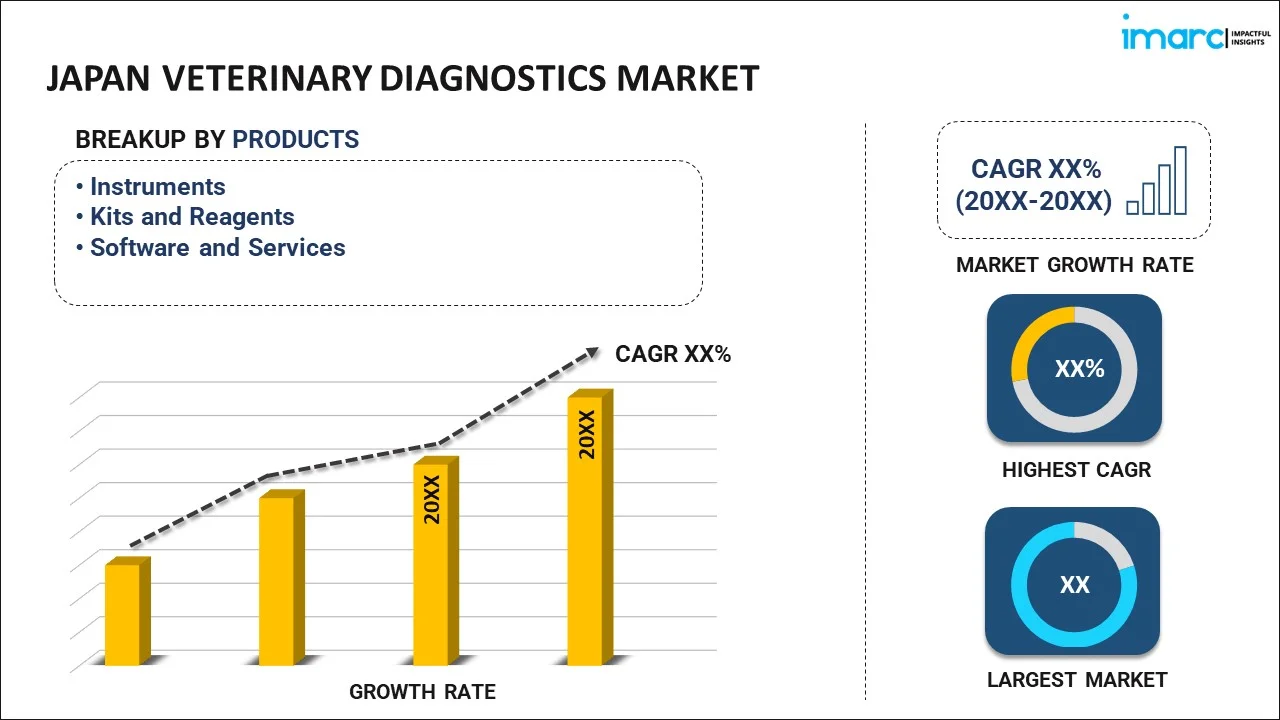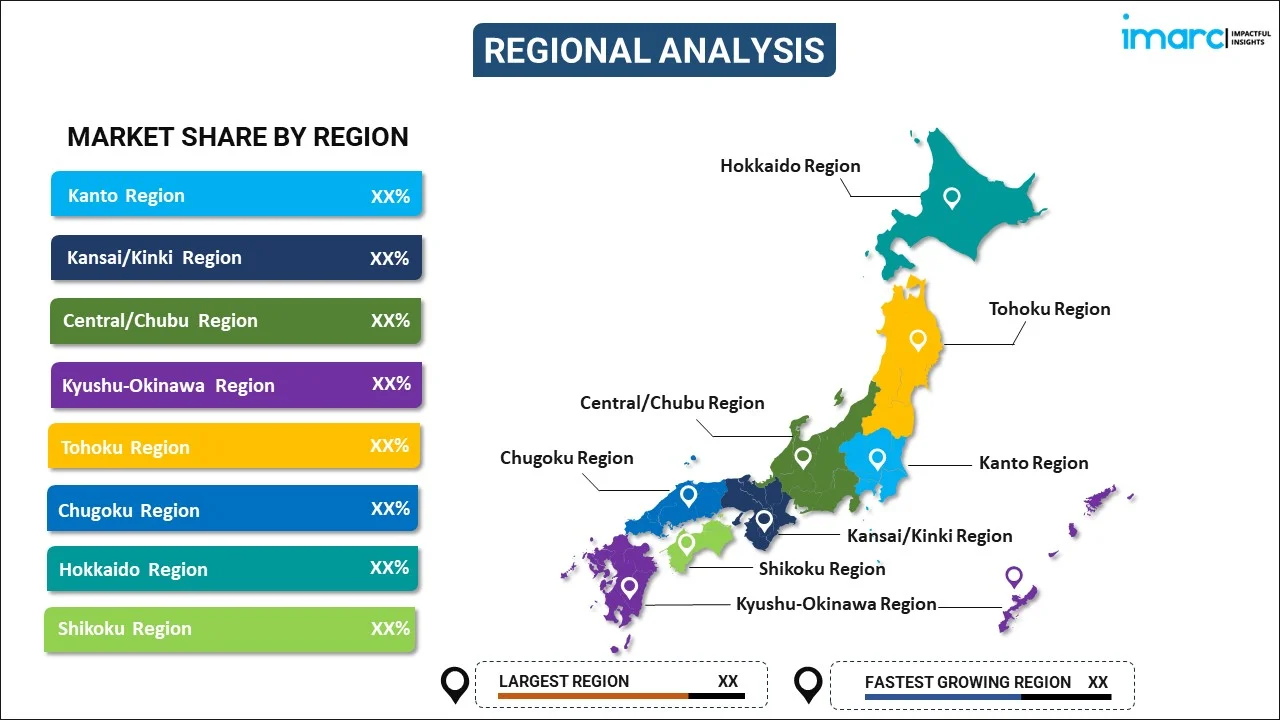
Japan Veterinary Diagnostics Market Report by Product (Instruments, Kits and Reagents, Software and Services), Technology (Immunodiagnostics, Clinical Biochemistry, Molecular Diagnostics, Hematology, and Others), Animal Type (Companion Animals, Livestock Animals), Disease Type (Infectious Diseases, Non-Infectious Diseases, Hereditary, Congenital and Acquired Diseases, General Ailments, Structural and Functional Diseases), End User (Reference Laboratories, Veterinary Hospitals and Clinics, and Others), and Region 2025-2033
Market Overview:
Japan veterinary diagnostics market size reached USD 248.5 Million in 2024. Looking forward, IMARC Group expects the market to reach USD 605.4 Million by 2033, exhibiting a growth rate (CAGR) of 9.5% during 2025-2033. The elevating awareness among individuals towards various health benefits associated with pet companionship, such as unconditional loyalty, love, and a source of comfort and stress relief is primarily driving the market growth.
|
Report Attribute
|
Key Statistics
|
|---|---|
|
Base Year
|
2024
|
|
Forecast Years
|
2025-2033
|
|
Historical Years
|
2019-2024
|
|
Market Size in 2024
|
USD 248.5 Million |
|
Market Forecast in 2033
|
USD 605.4 Million |
| Market Growth Rate 2025-2033 | 9.5% |
Veterinary diagnostics play a pivotal role in the veterinary field, serving as essential tools for veterinarians in the identification and assessment of diseases, injuries, and various health issues in animals. These diagnostic methods are indispensable for delivering precise medical care and formulating effective therapeutic strategies for animals. They empower veterinarians to accurately pinpoint the specific health ailment or condition affecting an animal. Moreover, they facilitate the early detection of diseases, often detecting issues even before clinical symptoms manifest, which is vital for timely intervention. Additionally, they furnish invaluable data that assists veterinarians in fine-tuning treatment plans and effectively managing chronic or persistent conditions in animals. Veterinary diagnostics also play a crucial role in identifying zoonotic diseases in animals, enabling the implementation of appropriate measures to control the transmission of these diseases.
Japan Veterinary Diagnostics Market Trends:
The veterinary diagnostics market in Japan has experienced notable growth and advancement, reflecting the country's commitment to the health and well-being of its diverse animal population. Japan's pet ownership culture, combined with its rigorous standards for animal healthcare, has propelled the veterinary diagnostics market forward. The market is characterized by a wide range of diagnostic tools and techniques, catering to companion animals, livestock, and wildlife. One of the driving factors behind the growth of the veterinary diagnostics market in Japan is the rising awareness among pet owners about the importance of early disease detection and preventive care for their beloved animals. This has led to an increased demand for diagnostic services and screening procedures for pets. Furthermore, Japan's strong livestock and agriculture sector places a premium on animal health and productivity. The veterinary diagnostics market is also benefiting from technological advancements, with innovative diagnostic tools, such as advanced imaging techniques, molecular diagnostics, and point-of-care testing, gaining prominence. These tools enable veterinarians to make faster and more accurate diagnoses, enhancing the overall quality of animal healthcare. As Japan continues to prioritize the well-being of its animals and uphold its commitment to quality healthcare, the veterinary diagnostics market is poised for sustained growth and innovation over the forecasted period.
Japan Veterinary Diagnostics Market Segmentation:
IMARC Group provides an analysis of the key trends in each segment of the market, along with forecasts at the country level for 2025-2033. Our report has categorized the market based on product, technology, animal type, disease type, and end user.
Product Insights:

- Instruments
- Kits and Reagents
- Software and Services
The report has provided a detailed breakup and analysis of the market based on the product. This includes instruments, kits and reagents, and software and services.
Technology Insights:
- Immunodiagnostics
- Clinical Biochemistry
- Molecular Diagnostics
- Hematology
- Others
A detailed breakup and analysis of the market based on the technology have also been provided in the report. This includes immunodiagnostics, clinical biochemistry, molecular diagnostics, hematology, and others.
Animal Type Insights:
- Companion Animals
- Dogs
- Cats
- Others
- Livestock Animals
- Cattle
- Swine
- Poultry
- Others
The report has provided a detailed breakup and analysis of the market based on the animal type. This includes companion animals (dogs, cats, and others) and livestock animals (cattle, swine, poultry, and others).
Disease Type Insights:
- Infectious Diseases
- Non-Infectious Diseases
- Hereditary, Congenital and Acquired Diseases
- General Ailments
- Structural and Functional Diseases
A detailed breakup and analysis of the market based on the disease type have also been provided in the report. This includes infectious diseases, non-infectious diseases, hereditary, congenital and acquired diseases, general ailments, and structural and functional diseases.
End User Insights:
- Reference Laboratories
- Veterinary Hospitals and Clinics
- Others
The report has provided a detailed breakup and analysis of the market based on the end user. This includes reference laboratories, veterinary hospitals and clinics, and others.
Regional Insights:

- Kanto Region
- Kansai/Kinki Region
- Central/ Chubu Region
- Kyushu-Okinawa Region
- Tohoku Region
- Chugoku Region
- Hokkaido Region
- Shikoku Region
The report has also provided a comprehensive analysis of all the major regional markets, which include Kanto Region, Kansai/Kinki Region, Central/ Chubu Region, Kyushu-Okinawa Region, Tohoku Region, Chugoku Region, Hokkaido Region, and Shikoku Region.
Competitive Landscape:
The market research report has also provided a comprehensive analysis of the competitive landscape. Competitive analysis such as market structure, key player positioning, top winning strategies, competitive dashboard, and company evaluation quadrant has been covered in the report. Also, detailed profiles of all major companies have been provided. Some of the key players include:
- IDEXX Laboratories KK
- Neogen Corporation
- Virbac
- Zoetis Japan
(Please note that this is only a partial list of the key players, and the complete list is provided in the report.)
Japan Veterinary Diagnostics Market Report Coverage:
| Report Features | Details |
|---|---|
| Base Year of the Analysis | 2024 |
| Historical Period | 2019-2024 |
| Forecast Period | 2025-2033 |
| Units | Million USD |
| Scope of the Report | Exploration of Historical Trends and Market Outlook, Industry Catalysts and Challenges, Segment-Wise Historical and Future Market Assessment:
|
| Products Covered | Instruments, Kits and Reagents, Software and Services |
| Technologies Covered | Immunodiagnostics, Clinical Biochemistry, Molecular Diagnostics, Hematology, Others |
| Animal Types Covered |
|
| Disease Types Covered | Infectious Diseases, Non-Infectious Diseases, Hereditary, Congenital and Acquired Diseases, General Ailments, Structural and Functional Diseases |
| End Users Covered | Reference Laboratories, Veterinary Hospitals and Clinics, Others |
| Regions Covered | Kanto Region, Kansai/Kinki Region, Central/ Chubu Region, Kyushu-Okinawa Region, Tohoku Region, Chugoku Region, Hokkaido Region, Shikoku Region |
| Companies Covered | IDEXX Laboratories KK, Neogen Corporation, Virbac, Zoetis Japan, etc. |
| Customization Scope | 10% Free Customization |
| Post-Sale Analyst Support | 10-12 Weeks |
| Delivery Format | PDF and Excel through Email (We can also provide the editable version of the report in PPT/Word format on special request) |
Key Questions Answered in This Report:
- How has the Japan veterinary diagnostics market performed so far and how will it perform in the coming years?
- What has been the impact of COVID-19 on the Japan veterinary diagnostics market?
- What is the breakup of the Japan veterinary diagnostics market on the basis of product?
- What is the breakup of the Japan veterinary diagnostics market on the basis of technology?
- What is the breakup of the Japan veterinary diagnostics market on the basis of animal type?
- What is the breakup of the Japan veterinary diagnostics market on the basis of disease type?
- What is the breakup of the Japan veterinary diagnostics market on the basis of end user?
- What are the various stages in the value chain of the Japan veterinary diagnostics market?
- What are the key driving factors and challenges in the Japan veterinary diagnostics?
- What is the structure of the Japan veterinary diagnostics market and who are the key players?
- What is the degree of competition in the Japan veterinary diagnostics market?
Key Benefits for Stakeholders:
- IMARC’s industry report offers a comprehensive quantitative analysis of various market segments, historical and current market trends, market forecasts, and dynamics of the Japan veterinary diagnostics market from 2019-2033.
- The research report provides the latest information on the market drivers, challenges, and opportunities in the Japan veterinary diagnostics market.
- Porter's five forces analysis assist stakeholders in assessing the impact of new entrants, competitive rivalry, supplier power, buyer power, and the threat of substitution. It helps stakeholders to analyze the level of competition within the Japan veterinary diagnostics industry and its attractiveness.
- Competitive landscape allows stakeholders to understand their competitive environment and provides an insight into the current positions of key players in the market.
Need more help?
- Speak to our experienced analysts for insights on the current market scenarios.
- Include additional segments and countries to customize the report as per your requirement.
- Gain an unparalleled competitive advantage in your domain by understanding how to utilize the report and positively impacting your operations and revenue.
- For further assistance, please connect with our analysts.
 Inquire Before Buying
Inquire Before Buying
 Speak to an Analyst
Speak to an Analyst
 Request Brochure
Request Brochure
 Request Customization
Request Customization




.webp)




.webp)












